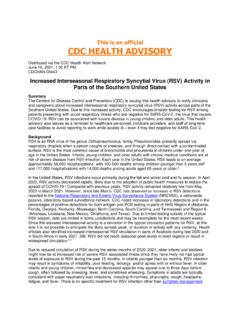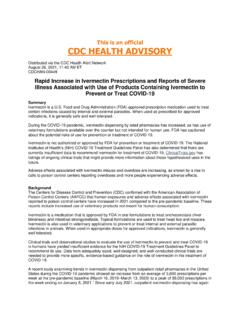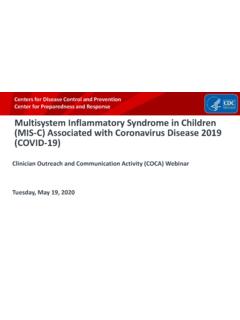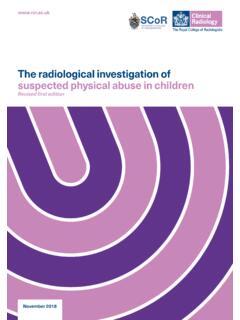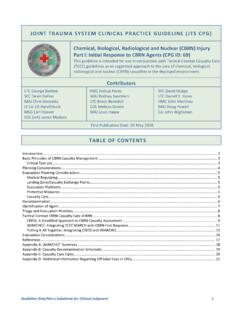Transcription of Glossary of Radiological Terms - CDC
1 Page 1 of 16 Glossary of Radiological Terms Absolute risk: the proportion of a population expected to get a disease over a specified time period. See also risk, relative risk. Absorbed dose: the amount of energy deposited by ionizing radiation in a unit mass of tissue. It is expressed in units of joule per kilogram (J/kg), and called gray (Gy). For more information, see Primer on Radiation Measurement at the end of this document. Activity (radioactivity): the rate of decay of radioactive material expressed as the number of atoms breaking down per second measured in units called becquerels or curies. Acute exposure: an exposure to radiation that occurred in a matter of minutes rather than in longer, continuing exposure over a period of time.
2 See also chronic exposure, exposure, fractionated exposure. Acute Radiation Syndrome (ARS): a serious illness caused by receiving a dose greater than 50 rads of penetrating radiation to the body in a short time (usually minutes). The earliest symptoms are nausea, fatigue, vomiting, and diarrhea. Hair loss, bleeding, swelling of the mouth and throat, and general loss of energy may follow. If the exposure has been approximately 1,000 rads or more, death may occur within 2 4 weeks. For more information, see CDC s fact sheet Acute Radiation Syndrome at Air burst: a nuclear weapon explosion that is high enough in the air to keep the fireball from touching the ground. Because the fireball does not reach the ground and does not pick up any surface material, the radioactivity in the fallout from an air burst is relatively insignificant compared with a surface burst.
3 For more information, see Chapter 2 of CDC s Fallout Report at Alpha particle: the nucleus of a helium atom, made up of two neutrons and two protons with a charge of +2. Certain radioactive nuclei emit alpha particles. Alpha particles generally carry more energy than gamma or beta particles, and deposit that energy very quickly while passing through tissue. Alpha particles can be stopped by a thin layer of light material, such as a sheet of paper, and cannot penetrate the outer, dead layer of skin. Therefore, they do not damage living tissue when outside the body. When alpha-emitting atoms are inhaled or swallowed, however, they are especially damaging because they transfer relatively large amounts of ionizing energy to living cells.
4 See also beta particle, gamma ray, neutron, x-ray. Ambient air: the air that surrounds us. Americium (Am): a silvery metal; it is a man-made element whose isotopes Am-237 through Am-246 are all radioactive. Am-241 is formed spontaneously by the beta decay of plutonium-241. Trace quantities of americium are widely used in smoke detectors, and as neutron sources in neutron moisture gauges. Atom: the smallest particle of an element that can enter into a chemical reaction. Atomic number: the total number of protons in the nucleus of an atom. Glossary of Radiological Terms (continued from previous page) August 2004 Page 2 of 16 Atomic mass unit (amu): 1 amu is equal to one twelfth of the mass of a carbon-12 atom.
5 Atomic mass number: the total number of protons and neutrons in the nucleus of an atom. Atomic weight: the mass of an atom, expressed in atomic mass units. For example, the atomic number of helium-4 is 2, the atomic mass is 4, and the atomic weight is Background radiation: ionizing radiation from natural sources, such as terrestrial radiation due to radionuclides in the soil or cosmic radiation originating in outer space. Becquerel (Bq): the amount of a radioactive material that will undergo one decay (disintegration) per second. For more information, see Primer on Radiation Measurement at the end of this document. Beta particles: electrons ejected from the nucleus of a decaying atom.
6 Although they can be stopped by a thin sheet of aluminum, beta particles can penetrate the dead skin layer, potentially causing burns. They can pose a serious direct or external radiation threat and can be lethal depending on the amount received. They also pose a serious internal radiation threat if beta-emitting atoms are ingested or inhaled. See also alpha particle, gamma ray, neutron, x-ray. Bioassay: an assessment of radioactive materials that may be present inside a person s body through analysis of the person s blood, urine, feces, or sweat. Biological Effects of Ionizing Radiation (BEIR) Reports: reports of the National Research Council's committee on the Biological Effects of Ionizing Radiation.
7 For more information, see Biological half-life: the time required for one half of the amount of a substance, such as a radionuclide, to be expelled from the body by natural metabolic processes, not counting radioactive decay, once it has been taken in through inhalation, ingestion, or absorption. See also radioactive half-life, effective half-life. Carcinogen: a cancer-causing substance. Chain reaction: a process that initiates its own repetition. In a fission chain reaction, a fissile nucleus absorbs a neutron and fissions (splits) spontaneously, releasing additional neutrons. These, in turn, can be absorbed by other fissile nuclei, releasing still more neutrons. A fission chain reaction is self-sustaining when the number of neutrons released in a given time equals or exceeds the number of neutrons lost by absorption in non-fissile material or by escape from the system.
8 Chronic exposure: exposure to a substance over a long period of time, possibly resulting in adverse health effects. See also acute exposure, fractionated exposure. Cobalt (Co): gray, hard, magnetic, and somewhat malleable metal. Cobalt is relatively rare and generally obtained as a byproduct of other metals, such as copper. Its most common radioisotope, cobalt-60 (Co-60), is used in radiography and medical applications. Cobalt-60 emits beta particles and gamma rays during radioactive decay. Collective dose: the estimated dose for an area or region multiplied by the estimated population in that area or region. For more information, see Primer on Radiation Measurement at the end of this document.
9 Glossary of Radiological Terms (continued from previous page) August 2004 Page 3 of 16 Committed dose: a dose that accounts for continuing exposures expected to be received over a long period of time (such as 30, 50, or 70 years) from radioactive materials that were deposited inside the body. For more information, see Primer on Radiation Measurement at the end of this document. Concentration: the ratio of the amount of a specific substance in a given volume or mass of solution to the mass or volume of solvent. Conference of Radiation Control Program Directors (CRCPD): an organization whose members represent state radiation protection programs. For more information, see the CRCPD website: Contamination (radioactive): the deposition of unwanted radioactive material on the surfaces of structures, areas, objects, or people where it may be external or internal.
10 See also decontamination. Cosmic radiation: radiation produced in outer space when heavy particles from other galaxies (nuclei of all known natural elements) bombard the earth. See also background radiation, terrestrial radiation. Criticality: a fission process where the neutron production rate equals the neutron loss rate to absorption or leakage. A nuclear reactor is "critical" when it is operating. Critical mass: the minimum amount of fissile material that can achieve a self-sustaining nuclear chain reaction. Cumulative dose: the total dose resulting from repeated or continuous exposures of the same portion of the body, or of the whole body, to ionizing radiation. For more information, see Primer on Radiation Measurement at the end of this document.

